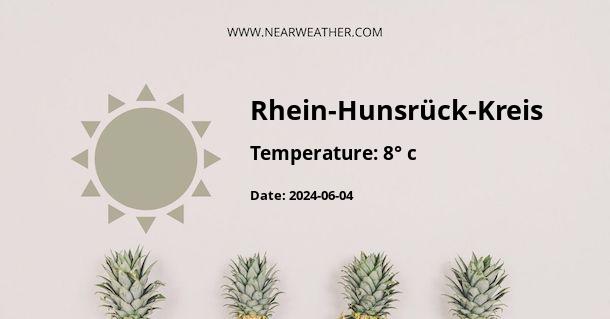Climate Overview of Rhein-Hunsrück-Kreis, Germany
The Rhein-Hunsrück-Kreis is a district in the west of Rhineland-Palatinate, Germany, characterized by the Hunsrück, a low mountain range, and its proximity to the Rhine River. This geographical position has a significant influence on its climate, which can be described as a transitional zone between the maritime climate of the west and the continental climate of the east. Understanding the local climate and weather patterns is crucial for agriculture, tourism, and day-to-day life within the region.
Seasonal Climate Patterns
The climate in Rhein-Hunsrück-Kreis is generally mild and is typical of the temperate zone, with distinct seasonal variations which we will discuss in this section.
Winter (December - February)
- Temperature: Winters can be quite cold with temperatures often dropping below freezing, especially during the night. The average temperature during this season ranges between -1°C to 4°C.
- Precipitation: Snowfall is common, although it tends to be moderate rather than heavy, contributing to a picturesque winter landscape.
- Weather events: Occasionally, the region can experience frost and ice, making travel in the area potentially challenging during these months.
Spring (March - May)
- Temperature: A gradual warming trend occurs, with temperatures climbing from an average low of 1°C in March to highs around 15°C by the end of May.
- Precipitation: Rainfall is common in spring, which is crucial for the growth of the local flora.
- Weather events: Late frosts in early spring can occasionally occur and have a noticeable impact on agricultural practices.
Summer (June - August)
- Temperature: Summers are warm without being excessively hot, with average temperatures ranging from 13°C to 24°C.
- Precipitation: Rainfall during the summer is relatively lower compared to other seasons, but thunderstorms are not uncommon.
- Weather events: Heatwaves can occur but are usually short-lived.
Autumn (September - November)
- Temperature: Temperatures begin to drop, with averages ranging from 6°C to 14°C.
- Precipitation: Rainfall increases as the season progresses, contributing to the region's autumnal foliage.
- Weather events: Fog can be more prevalent, particularly in areas close to the Rhine River due to temperature differences between the water and the surrounding air.
Year-Round Weather: Average Data and Extremes
"Rhein-Hunsrück-Kreis experiences a temperate climate where extreme weather conditions are rare, making it suitable for a wide range of outdoor activities throughout the year."
| Month | Average High (°C) | Average Low (°C) | Average Precipitation (mm) |
|---|---|---|---|
| January | 3 | -2 | 60 |
| February | 4 | -1 | 55 |
| March | 9 | 1 | 60 |
| April | 13 | 4 | 50 |
| May | 18 | 8 | 70 |
| June | 21 | 11 | 80 |
| July | 24 | 13 | 70 |
| August | 23 | 13 | 60 |
| September | 19 | 10 | 70 |
| October | 13 | 6 | 60 |
| November | 7 | 2 | 70 |
| December | 4 | -1 | 65 |
Impact of Climate on The Local Area
The Rhein-Hunsrück-Kreis climate impacts various aspects of local life and industries. These include:
- Agriculture: The region supports a range of agricultural activities. The mild climate and seasonal rainfall pattern are advantageous for growing grapes for wine, particularly Riesling, which flourishes along the Rhine. The risk of late spring frosts requires careful planning and monitoring by vintners.
- Forestry: The Hunsrück area has substantial forested regions. The temperate climate supports a diverse range of tree species and is conducive to sustainable forestry practices.
- Tourism: The district's scenic landscapes, including the Rhine Gorge, a UNESCO World Heritage Site, attract visitors all year round. The climate allows for hiking, cycling, and boating during warmer months, and in winter, the region's gentle slopes can be used for winter sports.
- Renewable Energy: The weather patterns of Rhein-Hunsrück-Kreis, with its consistent winds and moderate sunlight exposure, are suitable for wind and solar energy production, thus making it a leading region in renewable energy within Germany.
Future Climate Considerations
Like many regions worldwide, climate change poses a significant long-term threat that may alter the traditional climate patterns of Rhein-Hunsrück-Kreis. Anticipated effects include:
- Increase in average temperatures: leading to longer growing seasons but potentially also more frequent heatwaves and drought conditions, stressing water resources and agriculture.
- Rising frequency of extreme weather: which may cause more intense rainfall events, leading to flash flooding and erosion.
- Shifts in flora and fauna: as species may have to adapt to changing conditions or move to new areas, potentially altering local ecosystems.
While climate models offer predictions, there is inherent uncertainty about the specific impacts these changes will bring. Local governments, businesses, and citizens recognize the importance of climate mitigation and adaption strategies to maintain the region's vitality and resilience in the face of these challenges.
Final Thoughts on Rhein-Hunsrück-Kreis Climate
Rhein-Hunsrück-Kreis experiences a temperate climate that is generally favorable to a variety of activities and industries in the region. Understanding the detailed climate parameters and weather patterns year-round is essential for planning and preparedness in various sectors. As global climate patterns shift, the region must adapt to ensure its sustainability and quality of life for years to come.
A - Rhein-Hunsrück-Kreis's Latitude is 50.067780 & Longitude is 7.546670.
A - Weather in Rhein-Hunsrück-Kreis is 19° today.
A - Climate Conditions in Rhein-Hunsrück-Kreis shows few clouds today.
A - Humidity in Rhein-Hunsrück-Kreis is 63% today.
A - Wind speed in Rhein-Hunsrück-Kreis is 2.38 km/h, flowing at 129° wind direction. today.
